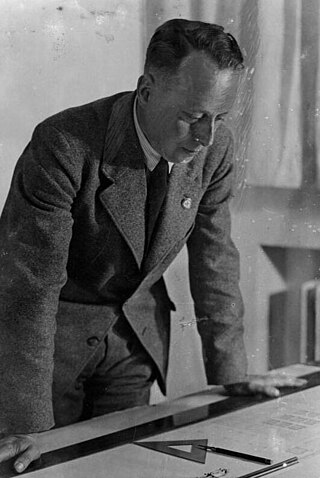Loading AI tools
German architect (1898–1987) From Wikipedia, the free encyclopedia
Hermann Giesler (2 April 1898 – 20 January 1987) was a German architect during the Nazi era, one of the two architects most favoured and rewarded by Adolf Hitler (the other being Albert Speer).
This article needs additional citations for verification. (May 2013) |

Hermann Giesler completed his architectural study at the Academy for Applied Arts in Munich. Starting from 1930 he worked as an independent architect. In 1933 he became master of building of districts in Sonthofen and 1937, became a professor.
Giesler was an early and enthusiastic Nazi. Up to 1938 he designed the "Ordensburg" in Sonthofen; planned Gau Forums in Weimar and Augsburg; and the "university" for the NSDAP at Chiemsee.[1] In addition, he was commissioned to build Hitler's house in Munich.
In 1938 he restored the Hotel Elephant, a 400-year-old Weimar inn. In December 1938 he was appointed by Hitler "General Building Inspector" for the reorganization of the city of Munich.[1] Later he became also a director in the Organisation Todt, then one of the directors of the Group of Works of VI (Bavaria, Donaugaue).
Starting in 1941, after fellow architect Roderich Fick fell out of political favour, Giesler was entrusted by Hitler with the reorganization of the entire city of Linz.[1] Beginning from 1942 he worked on plans and a large model for the Danube Development of the Banks. In August 1943, Giesler became a member of the Reichstag.[2] Starting from 1944, he also worked on designs for the cultural center, which Hitler regarded with particular interest.
Giesler joined the Nazi Party in 1941 in Organisation Todt (OT) as head of the "Assembly for the Baltic States Giesler", as head of the Einsatzgruppe Russia North of the OT (1942–1944), and as Director of the OT-Einsatzgruppe VI (Bayern und Danube gaue). Concentration camp prisoners built weapons in the underground factories (1944–1945).
Throughout the war, Giesler and Speer had several heated arguments about architectural styles.[1]: 346 In September 1944 Giesler was named one of the Reich's most important artists in the Gottbegnadeten list.
In 1945, Giesler was initially arrested by the U.S. military and interned as a Nazi, and charged in 1946. In 1947, he was indicted by a U.S. military court for war crimes in the concentration camp Mühldorf, a subcamp of Dachau. Giesler was sentenced to life imprisonment, but on 6 May 1948 his sentence was reduced to 25 years imprisonment. On 7 July 1951, it was lowered once again to twelve years. Giesler was freed on 18 October 1952. He settled in Düsseldorf, where he worked in 1953 as an independent architect and author. Giesler never renounced his Naziism.[1] He published autobiographical writings, which appeared both in right-wing publishers (see below), as a commitment to Nazism and Adolf Hitler. Giesler wrote Ein anderer Hitler (Another Hitler), a personal memoir about his relationship with the dictator. He died in 1987.
Seamless Wikipedia browsing. On steroids.
Every time you click a link to Wikipedia, Wiktionary or Wikiquote in your browser's search results, it will show the modern Wikiwand interface.
Wikiwand extension is a five stars, simple, with minimum permission required to keep your browsing private, safe and transparent.